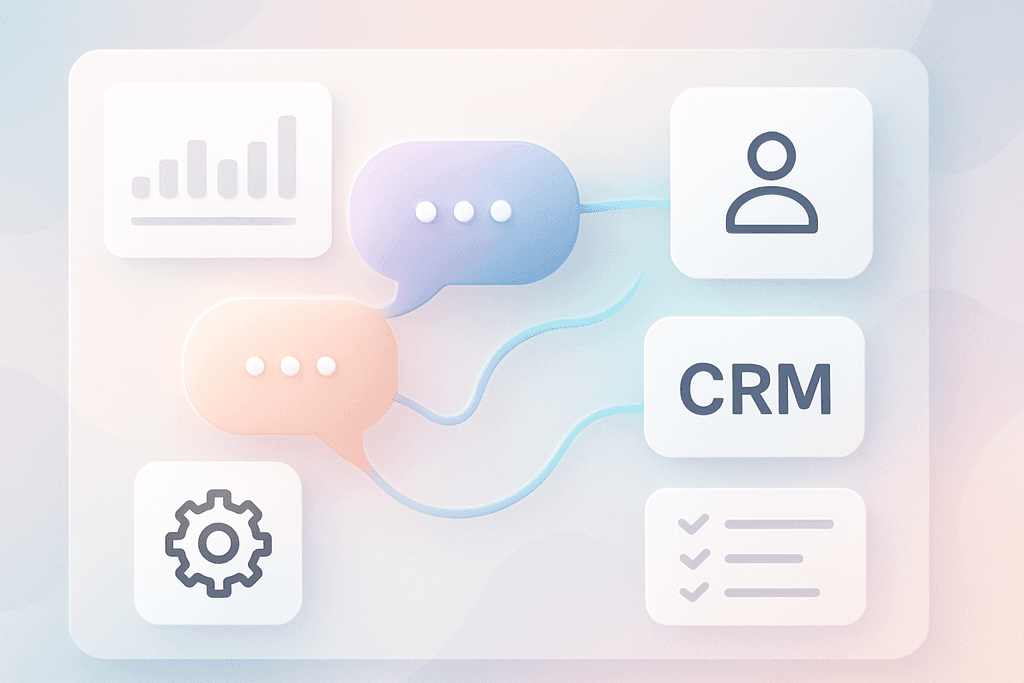Want your chatbot to answer questions with your exact prices, services, and policies? Here are the fastest, safest ways to import website data so your bot speaks in your business’s voice—without a rebuild.
Add your website in under a minute
What “website data import” means
Importing website data means feeding your chatbot the public information you already maintain online so it can answer with confidence. Think of it as letting your bot “read” your site and structured files, then reuse that content in conversations.
- Public pages: services, pricing, locations, about, policies, blog posts
- Structured sources: sitemap.xml, RSS/Atom feeds, product/FAQ schema, CSV/Sheets
- Files: PDFs, menus, brochures, guides, terms
- During the 2024 holiday season, shoppers used online chat services (including AI chatbots) 42% more year over year, according to Salesforce data reported by Reuters (Jan 6, 2025).
- Almost half of consumers used chatbots for scheduling, placing orders, returns, and tech support in late 2024 surveys (Statista, 2025).
The takeaway: customers are comfortable getting answers from chat—so your bot needs your latest site info.
The 3 fastest ways to bring site content into a chatbot
Below are practical options that work for most small businesses. Start with the quickest win, then layer the others for coverage and freshness.
1) Paste your URL and auto-crawl (zero-code)
Most modern chatbot platforms can crawl your public pages starting from a single URL. It’s fast and great for FAQs, services, and policy pages.
- Best for: small-to-medium sites, service menus, policy pages, simple product catalogs
- Pros: speed, minimal setup, broad coverage
- Watch-outs: skip duplicate pages and utility pages (cart, login), honor robots rules
- Confirm you own the content and are authorized to reuse it in a chatbot.
- Check your robots rules. The Robots Exclusion Protocol (robots.txt) is standardized as IETF RFC 9309; don’t block pages your bot needs.
- Ensure key pages are linked from your homepage so the crawler can find them.
- Remove or noindex junk pages you don’t want imported.
- Kick off the crawl, then test a few questions your customers actually ask.
Pro tip: Add structured data to make extraction easier. For products/services, use Schema.org Product so names, prices, and options are machine-readable.
2) Upload your sitemap.xml (fast coverage)
Already have a sitemap? Use it as a clean list of URLs to import. This reduces missed pages and avoids crawling navigation clutter.
- Locate your sitemap (often /sitemap.xml). If you don’t have one, generate one.
- Validate it and ensure it lists the pages you want the bot to use.
- Upload the sitemap or paste its URL in your chatbot’s data settings.
- Set a re-crawl schedule aligned to how often your site changes.
- When you launch new pages, update the sitemap first for near-instant inclusion.
Sitemaps follow an open standard. See the Sitemaps XML protocol for limits and examples.
3) Drag-and-drop docs or a CSV (precise facts)
For hours, fees, SKUs, menus, and “one source of truth” facts, upload PDFs or a simple CSV/Sheet. It gives your bot crisp, structured answers.
- Recommended columns (edit to fit): title, url, summary, category, price, availability, last_updated
- Split long PDFs (e.g., handbooks) into sections for better answers
- Include source URLs in a column so the bot can cite or deep-link
Connect data sources with integrations & APIs
When you want live data (inventory, appointments, CRM fields), connect systems directly. Start with plug-and-play integrations before writing code.
No-code integrations
Link your CRM and calendar so the bot can capture leads, book meetings, and log conversations automatically. Explore Small Business Chatbot integrations to connect with 700+ popular tools.
- Auto-create contacts and deals from chats
- Log transcripts to the right records
- Trigger workflows when a lead qualifies
Low-code APIs and webhooks
If you build your own endpoint, secure it like any production API. A practical starting checklist:
- Use HTTPS and strong authentication (tokens/keys rotated regularly).
- Validate and sanitize all inputs/outputs.
- Rate-limit requests and set timeouts.
- Log calls for audits; avoid logging secrets.
For common risks and mitigations, see the OWASP API Security Top 10 (2023).
Adoption is accelerating: Generative AI use has more than doubled year-over-year, with 24% of employed respondents using it for work and 83% of those users saying it boosts productivity (Deloitte Insights, 2024).
Keep content fresh (updates that stick)
Great imports go stale without a cadence. Use lightweight habits so your bot always reflects reality.
- Schedule re-crawls weekly for active blogs; daily for prices/menus that change often
- Re-upload updated CSVs on a calendar cadence (or automate via webhook)
- Tie bot refreshes to your site’s publishing workflow
- Track unanswered questions and add pages or rows to cover the gaps
- Assign an owner for “chatbot content” in your team.
- Review analytics monthly to see which URLs the bot used most.
- Archive outdated pages so they stop showing in answers.
Avoid these common pitfalls
Most issues are avoidable with a quick double-check before you import.
- Blocking key URLs in robots.txt → allow the pages your bot needs
- Feeding messy HTML or duplicate pages → prefer sitemap/CSV for precision
- Exposing private data → never rely on robots.txt for security; use real auth
- Unsecured APIs → audit against the OWASP Top 10 before going live
If you handle sensitive or regulated information, align your process with the NIST AI Risk Management Framework (2023) to manage AI risks, including data quality and governance.
Why Small Business Chatbot is the quicker path
Small Business Chatbot is built for speed and accuracy for small teams:
- 1-minute setup: paste your URL and start answering questions
- Smart ingestion: crawl, sitemap, files, or structured CSV/Sheets
- Live workflows: capture leads, book meetings, and sync notes via integrations
- Proof, not promises: see real outcomes from peers on our customer reviews page
Typical approaches vs. Small Business Chatbot
- Typical: manual copying, ad-hoc crawling, inconsistent updates.
- With Small Business Chatbot: guided import flows, automated refreshes, and integrations that push data where it needs to go.
Frequently asked questions for importing website data into your chatbot
1) Do I need a developer to import website data?
No. For most small sites you can start with a URL crawl or sitemap upload. Use APIs later for live data like inventory or bookings.
2) Will robots.txt stop my chatbot from seeing pages?
It can. Robots rules are a web standard (see IETF RFC 9309), so be sure you’re not blocking pages your bot needs. Note: robots.txt is not a security control.
3) What’s the best format for a CSV import?
Keep it simple and consistent. Include a unique title, a short summary, a source URL, and any key attributes (price, hours, location, last_updated).
4) How often should I re-import?
Match your site cadence. Weekly is fine for most; daily for frequently changing menus/prices; immediate refresh when policy or hours change.
5) Can the bot cite the exact page it used?
Yes—if you import with URLs. Add a column for source_url in CSVs and keep sitemap links current so the bot can provide a reference.
6) Is there a compliance framework I should be aware of?
Yes. If your use touches on risk-sensitive data, review the NIST AI RMF for governance and data quality practices.
Wrap-up
Start simple: crawl or upload a sitemap for coverage, then add a CSV for exact facts and connect integrations for live data. With a light maintenance habit, your bot stays accurate and helpful.



